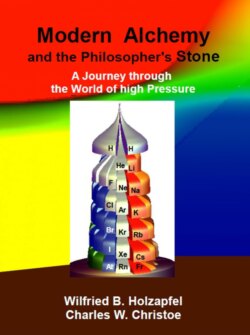Читать книгу Modern Alchemy and the Philosopher's Stone - Wilfried B. Holzapfel - Страница 43
На сайте Литреса книга снята с продажи.
Our Earth
Оглавление“In the meantime, I would like to give you a feeling for the high pressures and high temperatures that occur in nature by having a look at the conditions in the interior of Earth." He reached for another chart from the stack on his desk. In this illustration, (Figure 18) you can see a wedge that represents a rough section of Earth. The brown Earth's crust with the dark brown land masses and blue sea is about 40 km thick. Its physical properties are very different from the properties of Earth’s mantle just below it. The deepest oceanic trench is 11 km deep. Since a ten-meter-high column of water produces a pressure of about 1 bar on the ground below it, the pressure at the lowest point of these trenches is more than thousand times larger, that is more than 1000 bar or one kilobar.”
Helen had a question. “Professor,” she said, “you are talking about ‘one bar of pressure,’ but in the weather report on TV the annoucers report the atmospheric pressure in ‘inches’. From my high-school courses, I know that that refers to ‘inches of mercury.” Sometimes I listen to a special weather forecast for gliders. There I've heard the atmospheric pressure reported in millibars. I have even heard pressures reported in hectopascal (hPa). Why is that?”
“To resolve the earlier confusion of the various units in science and technology, scientists have agreed on an international system of units. We refer to this set of agreed-upon scientific units as SI units, from the French term for it, Système International d'Unités.
In this set of units, pressure is reported in pascals, abbreviated Pa. If you have not encountered this term in your classes up to now, you can think of one pascal as being the pressure produce by one newton of force acting over an area of one square meter. I’m sure that Marie is quite familiar with newtons and meters from her physics course. Instead of mbar for millibar, kbar for 1000 bar, and Mbar for 1000 kbar, the SI system uses appropriate prefixes for the Pa. As you have noted, workers in some fields of technology still report pressure in psi, or pounds per square inch. Sometimes you see even older pressure units such as millimeters of mercury or, possibly, the Torr. These units are common in blood pressure reports. They are still permitted there because, if you think about it, it would be too dangerous to risk having medical doctors getting mixed up with more modern units.”
“By international convention, scientists may still use the bar, or 1000 mbar as an approximation to one atmosphere of pressure – that is roughly our normal atmospheric pressure. The tire pressure on your bikes, especially the higher-pressure tires, is usually specified either in bar or psi. As you mentioned, atmospheric pressure is officially measured in pascal or hectopascal, but the weather report in the U.S. is often reported in inches of Mercury, meaning the height of a column of Mercury in a vertical tube with a vacuum above it. Normal atmospheric pressure is about 30 inches of Mercury. In other countries, they use 1000 hPa =100 kPa = 100 000 Pa to report a pressure of one atmosphere or 1 bar. You will see that the pascal is a very small unit for me to use when I describe the pressures in the experiments that we will be talking about. Even the hectopascal, or hPa, meaning one-hundred Pa; the kilopascal, kPa for a thousand Pa; and the megapascal, MPa for a million Pa, are not commonly used in my special field. We will find that the gigapascal, GPa, that stands for a billion Pa, is a handy unit for our journeys through the land of high pressure. Most of the maps will have a vertical axis that corresponds to pressure in the range of 3 to 300 GPa.”
“If I kept all of this straight,” Marie suggested, “normal atmospheric pressure is about 0.0001 GPa, right?”
“Right!” Professor Wood confirmed. “Do you agree, Helen?” he asked.
Helen nodded. “Now I understand why the pressures are expressed both in bar, kbar and Mbar and in hPa, MPa and GPa in this picture! I see that the pressure inside Earth reaches one GPa before we even get into the mantle. That corresponds to 10 kbar or ten-thousand times the atmospheric pressure at the surface where we are!”
The professor concurred. “Right, again!” he said. “By the time that they reach that pressure, the properties of many naturally occurring materials have already changed significantly. This is quite important for the professional field of Earth Science. As you have undoubtedly also noted, the pressure at the center of Earth is about 3.6 Mbar, or 360 GPa. That is the area we want to explore in more detail on our trips.”
“How do we know about these various layers deep within Earth’s surface?” Marie asked. “How can we even estimate what the pressure is at those depths?”
“Good question,” Professor Wood responded. “Similar to the way in which doctors are able to scan the human body with their tomography instruments, geologists can gain information about Earth's interior using seismic stations. Typically they use earthquakes that occur near the surface of Earth as the source of seismic pressure waves. They compare how long it takes for the seismic wave to arrive at various other points on the surface of Earth. They can compare the speed at which the wave must have propagated. There are physical models for how the speed of these waves depends upon the material traversed and its density. After many, many observations, they have been able to construct a model like the one that we see here (Figure 18).”
